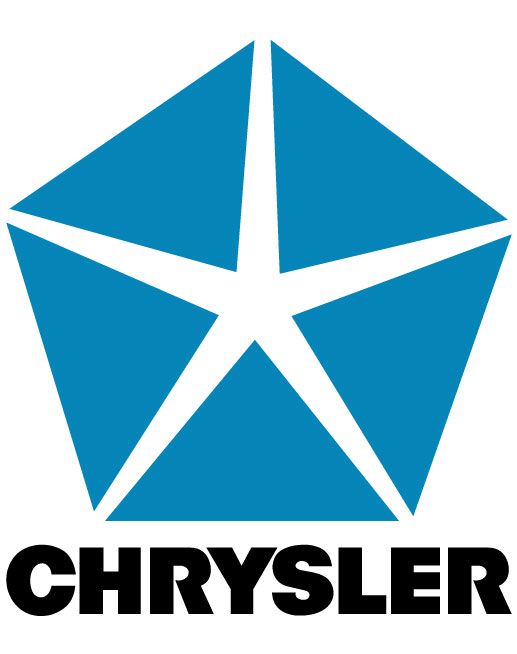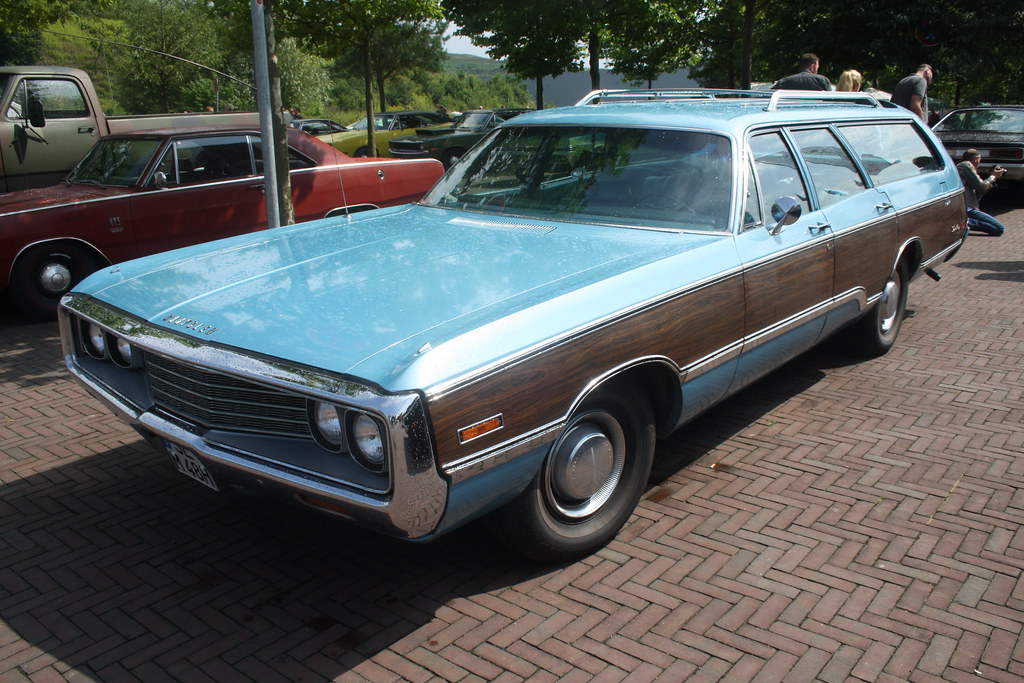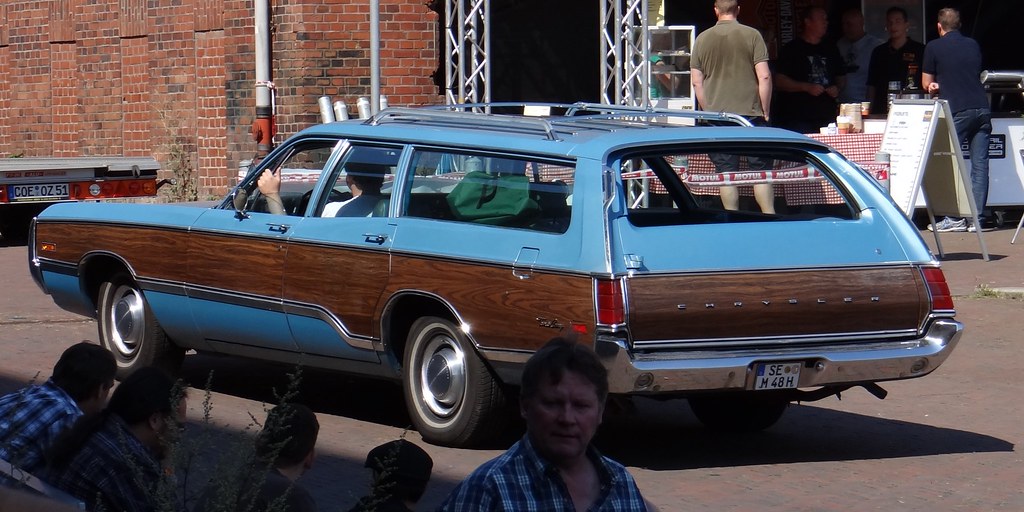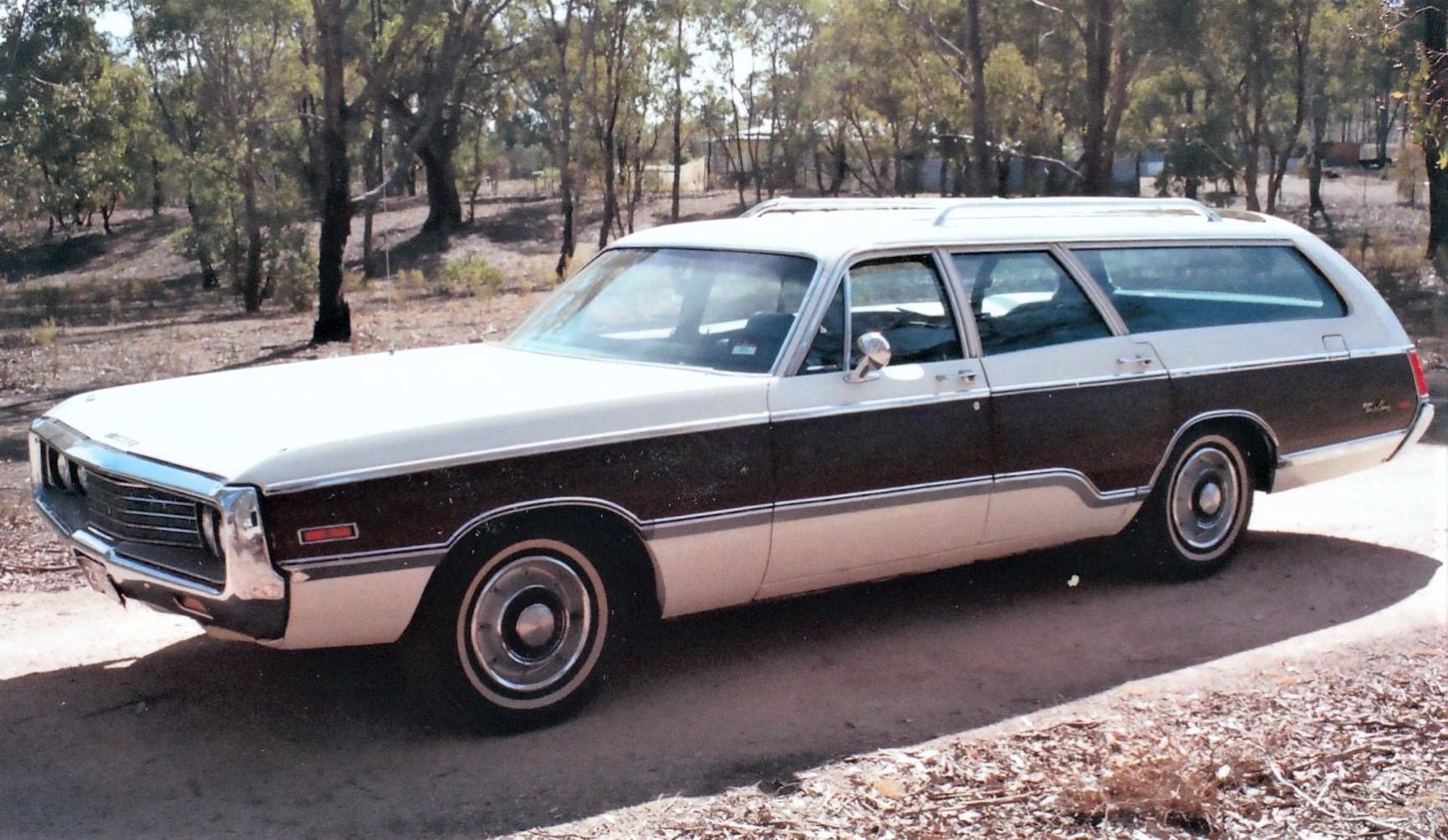mmcartalk
Expert
- Messages
- 4,155
- Reactions
- 2,675
MM Retro Write-Up: 1970 Chrysler Town and Country





(Interior shown in Green....couldn't find a light blue one to match my uncle's)
To those of the Baby-Boomer generation reading this (and those not of that generation who are familiar with automotive history), you will know, of course, that a lot of truly gargantuan-sized American station-wagons were built from the late 1950s to the mid/late 1970s, when downsizing from the first fuel-crisis hit in full-force. These classic mile-long people-haulers essentially ruled the driveways of large American families before the first Chrysler minivans hit the scene in 1984...the minivans are another whole phenomena unto themselves, and I may do a future write-up on them.
In this write-up, I want to focus on just one of these big family-haulers....my late uncle's light-blue 1970 Chrysler Town and Country. He had previously had a similar 1969 T&C, but, typical of many larger Chrysler products of the late 1960s, it proved so troublesome that somehow (I don't remember the details) after only one year, the local Chrysler dealership was willing to replace it with a new 1970 at a good price. Normally, a one-year depreciation, especially on a big car like that, would be taking quite a bath, but they worked out some kind of a deal, and, besides, my uncle and aunt, being well-heeled persons themselves financially (more on that below), could have eaten the depreciation if they had to.
Anyhow, I'll start with how I got to see it and drive it. As young teen-ager, I absolutely LOVED to drive, but drive safely......none (or at least almost none) of the vehicle-abuse, drag-racing, or aggressive-driving crap I saw some of my friends and classmates do. I simply felt at home behind the wheel, and would drive anything on four wheels if and when I got the chance to. I especially had a love of driving in the Appalachians, on older winding roads...boring Interstates, unless I was in a hurry, were just not my forte. Skyline Drive, which rides the crest of the Blue Ridge Mountains in Virginia's Shenandoah National Park, was my all-time favorite road, though I also had a fascination with the old National Road (today's Route 40, Maryland 144, and Scenic 40) that was the first Federally-funded road to cut a path west, across the Maryland and Pennsylvania mountains, to Ohio, linking the East Coast with the Midwest. Driving that route was not only an enriching experience but a lesson in history as well.
So, when I graduated from high school in June of 1970 (I was still living at home, with my parents, in suburban Virginia), I got my diploma, packed my bags, and set off, the very next morning after graduating, to see my aunt and uncle, my first truly long-distance trip driving alone beyond about a 100-mile radius or so. I was driving my Dad's medium-blue Plymouth Valiant, with its trusty 3.7L Slant-Six engine, three-on-the-tree column-shift manual transmission, and, aside from an AM radio and heater, an almost complete lack of modern conveniences......you opened the windows (and the small vent-windows) for air-conditioning. I had previously driven many miles locally in that car, and knew it like the back of my hand....I would have driven it anywhere.
My aunt and uncle were glad that I had successfully graduated, and were happy to have me come up and spend some time with them. I won't dwell on my long solo trip over the older, winding roads, across the mountains, and through towns to Ohio (that might be the subject of a future write-up), but it was worth the trip, which, to me, was fascinating, although, used to Virginia, I was unprepared for some of the dirty, environmentally-polluted conditions I saw in the Pittsburgh area, with its then-heavy industry, for the first time. My uncle, a well-known surgeon in Northeast Ohio, was married to my late mother's biological sister, a retired nurse....they, and their son/daughter (my cousins) lived in a large, very nice house, wth a double-inside garage, on the outskirts of Kent, about 30 miles or so from Cleveland, right in the middle of Ohio's famous Snow Belt, although it was June and not a factor on that trip. He had a local office/clinic in his own, in town, and also worked at a large local hospital in Ravenna...the same hospital where the students at Kent State University, in the town, who had been shot in campus-rioting only a month before, had been brought. My uncle had been part of the doctor-team called when the wounded students arrived...the rest is history, and I won't get into that here.
OK, so much for me, the trip, and them. Now for the cars. At the time, they owned the 1970 Town and Country and a large 1970 Oldsmobile Delta 88 (the Chrysler wagon was for the wife and kids....he was an Olds/Buick/Cadillac fan). For the moment, they had two RWD vehicles (and snow tires) that they struggled through the snowy Ohio winters in, although he was to convert, later, to a FWD Olds Toronado, and she to a 4WD Jeep Wagoneer, which, years before the Ford Explorer, was arguably the first true family-oriented SUV. These more winter-capable vehicles, for them, became a necessity after they bought their next house the following year, north of town, on a lakeside, with a severely-sloped driveway, which was virtually impossible to get up and down safely in the winter if the electrically-heated grid for the driveway (which melted the snow and ice) failed.
But, for now, it was the Olds Delta and the Town and Country. Even though I had seen many large wagons throughout the 1960s (and had driven a couple), I was still struck by the physical size of that car....it was almost 19 feet long, almost 7 feet wide, and had a wheelbase well over 10 feet long. It was noticeably larger even than their full-size Olds. Even in their large double-garage, parking this beast was dicey....as was low-speed maneuverability in tight places. That was why my aunt was more than happy to forget the driving during the several days I spent with them, and let me, who loved to drive virtually anything on four wheels, essentially be her chauffeur. I didn't like the way the town of Kent regulated their side-streets...they were one of the first places to get 4-way stop-signs (which I still despise) every couple of blocks or so, which meant constant starting/stopping (just like today, in my area). But we also got out on some of Ohio's more unobstructed roads, too, where I got a good idea of how this car cruised at moderate speeds.
Overall, even though it replaced an even more troublesome 1969, I wasn't impressed with how this car was built....the late 1960s, after about 1967, started a long period of sloppily-built Chrysler products, which to some extent, still endures even today, a half-century later. Nor was I impressed with the trim materials and over-use of dull-looking plastic/vinyl inside....I could see why my uncle preferred the well-detailed GM products of the time. Perhaps the car's best features were: First, the tough-as-nails, iron-block 440 cubic inch (7.2L) V8 and 4-barrel carburetor, which cranked out 375 HP and an estimated 450 ft-lbs. of torque.....in a two-and-a half-ton vehicle. Second, the torsion-bar-front/leaf-rear suspension, which was a little stiffer than the Ford/GM coil-springs, but allowed for somewhat better handling. Third, the also-tough 3-speed RWD Torqueflite automatic, which didn't shift quite as smoothly or quietly as the GM Turbo-Hydra-Matic, but was somewhat more efficient, though gas-mileage was not a big concern for people who bought cars like this. But, as I mentioned, the car was rather loosely-built, squeaked/rattled some in spite of its one-piece unitized body-shell, and just didn't seem as nice inside as the big Mercury/Buick/Olds/Pontiac wagons it competed against. The torsion-bar suspension and unitized body, despite attempts by Chrysler to address the issue, also let in more road noise and vibration from the front tires than typical coil springs and separate body-on-frame construction. The exhaust, like on some other large Chrysler V8s of the period, had a somewhat loud nasal tone. It did, however, have one interesting feature inside, something that I have seen on very few vehicles.....at night, instead of having each instrument and control on the dash lit by separate bulb, the entire driver's dash-panel was lit up by a single large floodlight hidden above the dash, which shone down on it. Nifty idea, and generally solved the problem of having unlighted switches/controls. And, although it did flood out once when trying to start it, the single 4-barrel carburetor on that 440 was generally a lot less finicky than the 2-barrel Carter carburetors that were used on downrated versions of some Chrysler engines.
While I was there, in the driveway, I hand-washed both the Olds and the Chrysler for them...the start of a tradition I would do whenever I visited them later on. The severe winters of that area, combined with the limited rust-proofing capabilities of that time (plus the fact that they were not as detail-oriented as I was in taking care of a car) made it much more difficult to keep their cars in the same condition/cleanliness that I was used to back home in the D.C. area and its milder climate. Before I left for the long trip back home to D.C. (I was tired, and went back home on the turnpikes this time), the radiator in my Dad's Valiant sprung a small leak there in Kent, and they repaid me for the car-wash and chauffeur-services by being kind enough, at their expense, to have the radiator fixed and new coolant put in at a local shop there in Kent. I don't remember exactly what shop it was.....might have even been the Chrysler-Plymouth dealership there, whose mechanics knew Valiants. Too bad the Valiant's other features and hardware (including the radiator) didn't match the bulletproof reliability of the famous Slant-Six engine's internals....those engines would routinely go 200,000 miles or more (if the rest of the car didn't fall apart around them), at a time when most engines had a difficult time reaching 90-100K miles without undue oil-usage and power-loss.
Gargantuan wagons like that, particularly in Suburbia, continued to dot the American landscape, even through the major gas-crises of the 1970s, until Lee Iacocca and Hal Sperlich, at Chrysler, got the idea to introduce the first FWD minivans in 1984. Previously, the RWD/rear-engined air-cooled VW Microbus had been around for decades, but was quirky, tricky to drive, lacked adequate heat/defrost, unstable on the road in crosswinds, severely underpowered, and just not suited for most American families.......it found most of its American sales in the Hippie/drug-counterculture movement of the 1960s. Iacocca and Sperlich had earlier presented the minivan idea to Henry Ford II when they worked there...King Henry rewarded them both by showing them the door. Well, they got their chance, at Chrysler, when Iacocca himself was the new Chairman....and the rest is history.
And, as Always, Happy-Car-Memories.

MM




(Interior shown in Green....couldn't find a light blue one to match my uncle's)
To those of the Baby-Boomer generation reading this (and those not of that generation who are familiar with automotive history), you will know, of course, that a lot of truly gargantuan-sized American station-wagons were built from the late 1950s to the mid/late 1970s, when downsizing from the first fuel-crisis hit in full-force. These classic mile-long people-haulers essentially ruled the driveways of large American families before the first Chrysler minivans hit the scene in 1984...the minivans are another whole phenomena unto themselves, and I may do a future write-up on them.
In this write-up, I want to focus on just one of these big family-haulers....my late uncle's light-blue 1970 Chrysler Town and Country. He had previously had a similar 1969 T&C, but, typical of many larger Chrysler products of the late 1960s, it proved so troublesome that somehow (I don't remember the details) after only one year, the local Chrysler dealership was willing to replace it with a new 1970 at a good price. Normally, a one-year depreciation, especially on a big car like that, would be taking quite a bath, but they worked out some kind of a deal, and, besides, my uncle and aunt, being well-heeled persons themselves financially (more on that below), could have eaten the depreciation if they had to.
Anyhow, I'll start with how I got to see it and drive it. As young teen-ager, I absolutely LOVED to drive, but drive safely......none (or at least almost none) of the vehicle-abuse, drag-racing, or aggressive-driving crap I saw some of my friends and classmates do. I simply felt at home behind the wheel, and would drive anything on four wheels if and when I got the chance to. I especially had a love of driving in the Appalachians, on older winding roads...boring Interstates, unless I was in a hurry, were just not my forte. Skyline Drive, which rides the crest of the Blue Ridge Mountains in Virginia's Shenandoah National Park, was my all-time favorite road, though I also had a fascination with the old National Road (today's Route 40, Maryland 144, and Scenic 40) that was the first Federally-funded road to cut a path west, across the Maryland and Pennsylvania mountains, to Ohio, linking the East Coast with the Midwest. Driving that route was not only an enriching experience but a lesson in history as well.
So, when I graduated from high school in June of 1970 (I was still living at home, with my parents, in suburban Virginia), I got my diploma, packed my bags, and set off, the very next morning after graduating, to see my aunt and uncle, my first truly long-distance trip driving alone beyond about a 100-mile radius or so. I was driving my Dad's medium-blue Plymouth Valiant, with its trusty 3.7L Slant-Six engine, three-on-the-tree column-shift manual transmission, and, aside from an AM radio and heater, an almost complete lack of modern conveniences......you opened the windows (and the small vent-windows) for air-conditioning. I had previously driven many miles locally in that car, and knew it like the back of my hand....I would have driven it anywhere.
My aunt and uncle were glad that I had successfully graduated, and were happy to have me come up and spend some time with them. I won't dwell on my long solo trip over the older, winding roads, across the mountains, and through towns to Ohio (that might be the subject of a future write-up), but it was worth the trip, which, to me, was fascinating, although, used to Virginia, I was unprepared for some of the dirty, environmentally-polluted conditions I saw in the Pittsburgh area, with its then-heavy industry, for the first time. My uncle, a well-known surgeon in Northeast Ohio, was married to my late mother's biological sister, a retired nurse....they, and their son/daughter (my cousins) lived in a large, very nice house, wth a double-inside garage, on the outskirts of Kent, about 30 miles or so from Cleveland, right in the middle of Ohio's famous Snow Belt, although it was June and not a factor on that trip. He had a local office/clinic in his own, in town, and also worked at a large local hospital in Ravenna...the same hospital where the students at Kent State University, in the town, who had been shot in campus-rioting only a month before, had been brought. My uncle had been part of the doctor-team called when the wounded students arrived...the rest is history, and I won't get into that here.
OK, so much for me, the trip, and them. Now for the cars. At the time, they owned the 1970 Town and Country and a large 1970 Oldsmobile Delta 88 (the Chrysler wagon was for the wife and kids....he was an Olds/Buick/Cadillac fan). For the moment, they had two RWD vehicles (and snow tires) that they struggled through the snowy Ohio winters in, although he was to convert, later, to a FWD Olds Toronado, and she to a 4WD Jeep Wagoneer, which, years before the Ford Explorer, was arguably the first true family-oriented SUV. These more winter-capable vehicles, for them, became a necessity after they bought their next house the following year, north of town, on a lakeside, with a severely-sloped driveway, which was virtually impossible to get up and down safely in the winter if the electrically-heated grid for the driveway (which melted the snow and ice) failed.
But, for now, it was the Olds Delta and the Town and Country. Even though I had seen many large wagons throughout the 1960s (and had driven a couple), I was still struck by the physical size of that car....it was almost 19 feet long, almost 7 feet wide, and had a wheelbase well over 10 feet long. It was noticeably larger even than their full-size Olds. Even in their large double-garage, parking this beast was dicey....as was low-speed maneuverability in tight places. That was why my aunt was more than happy to forget the driving during the several days I spent with them, and let me, who loved to drive virtually anything on four wheels, essentially be her chauffeur. I didn't like the way the town of Kent regulated their side-streets...they were one of the first places to get 4-way stop-signs (which I still despise) every couple of blocks or so, which meant constant starting/stopping (just like today, in my area). But we also got out on some of Ohio's more unobstructed roads, too, where I got a good idea of how this car cruised at moderate speeds.
Overall, even though it replaced an even more troublesome 1969, I wasn't impressed with how this car was built....the late 1960s, after about 1967, started a long period of sloppily-built Chrysler products, which to some extent, still endures even today, a half-century later. Nor was I impressed with the trim materials and over-use of dull-looking plastic/vinyl inside....I could see why my uncle preferred the well-detailed GM products of the time. Perhaps the car's best features were: First, the tough-as-nails, iron-block 440 cubic inch (7.2L) V8 and 4-barrel carburetor, which cranked out 375 HP and an estimated 450 ft-lbs. of torque.....in a two-and-a half-ton vehicle. Second, the torsion-bar-front/leaf-rear suspension, which was a little stiffer than the Ford/GM coil-springs, but allowed for somewhat better handling. Third, the also-tough 3-speed RWD Torqueflite automatic, which didn't shift quite as smoothly or quietly as the GM Turbo-Hydra-Matic, but was somewhat more efficient, though gas-mileage was not a big concern for people who bought cars like this. But, as I mentioned, the car was rather loosely-built, squeaked/rattled some in spite of its one-piece unitized body-shell, and just didn't seem as nice inside as the big Mercury/Buick/Olds/Pontiac wagons it competed against. The torsion-bar suspension and unitized body, despite attempts by Chrysler to address the issue, also let in more road noise and vibration from the front tires than typical coil springs and separate body-on-frame construction. The exhaust, like on some other large Chrysler V8s of the period, had a somewhat loud nasal tone. It did, however, have one interesting feature inside, something that I have seen on very few vehicles.....at night, instead of having each instrument and control on the dash lit by separate bulb, the entire driver's dash-panel was lit up by a single large floodlight hidden above the dash, which shone down on it. Nifty idea, and generally solved the problem of having unlighted switches/controls. And, although it did flood out once when trying to start it, the single 4-barrel carburetor on that 440 was generally a lot less finicky than the 2-barrel Carter carburetors that were used on downrated versions of some Chrysler engines.
While I was there, in the driveway, I hand-washed both the Olds and the Chrysler for them...the start of a tradition I would do whenever I visited them later on. The severe winters of that area, combined with the limited rust-proofing capabilities of that time (plus the fact that they were not as detail-oriented as I was in taking care of a car) made it much more difficult to keep their cars in the same condition/cleanliness that I was used to back home in the D.C. area and its milder climate. Before I left for the long trip back home to D.C. (I was tired, and went back home on the turnpikes this time), the radiator in my Dad's Valiant sprung a small leak there in Kent, and they repaid me for the car-wash and chauffeur-services by being kind enough, at their expense, to have the radiator fixed and new coolant put in at a local shop there in Kent. I don't remember exactly what shop it was.....might have even been the Chrysler-Plymouth dealership there, whose mechanics knew Valiants. Too bad the Valiant's other features and hardware (including the radiator) didn't match the bulletproof reliability of the famous Slant-Six engine's internals....those engines would routinely go 200,000 miles or more (if the rest of the car didn't fall apart around them), at a time when most engines had a difficult time reaching 90-100K miles without undue oil-usage and power-loss.
Gargantuan wagons like that, particularly in Suburbia, continued to dot the American landscape, even through the major gas-crises of the 1970s, until Lee Iacocca and Hal Sperlich, at Chrysler, got the idea to introduce the first FWD minivans in 1984. Previously, the RWD/rear-engined air-cooled VW Microbus had been around for decades, but was quirky, tricky to drive, lacked adequate heat/defrost, unstable on the road in crosswinds, severely underpowered, and just not suited for most American families.......it found most of its American sales in the Hippie/drug-counterculture movement of the 1960s. Iacocca and Sperlich had earlier presented the minivan idea to Henry Ford II when they worked there...King Henry rewarded them both by showing them the door. Well, they got their chance, at Chrysler, when Iacocca himself was the new Chairman....and the rest is history.
And, as Always, Happy-Car-Memories.

MM
